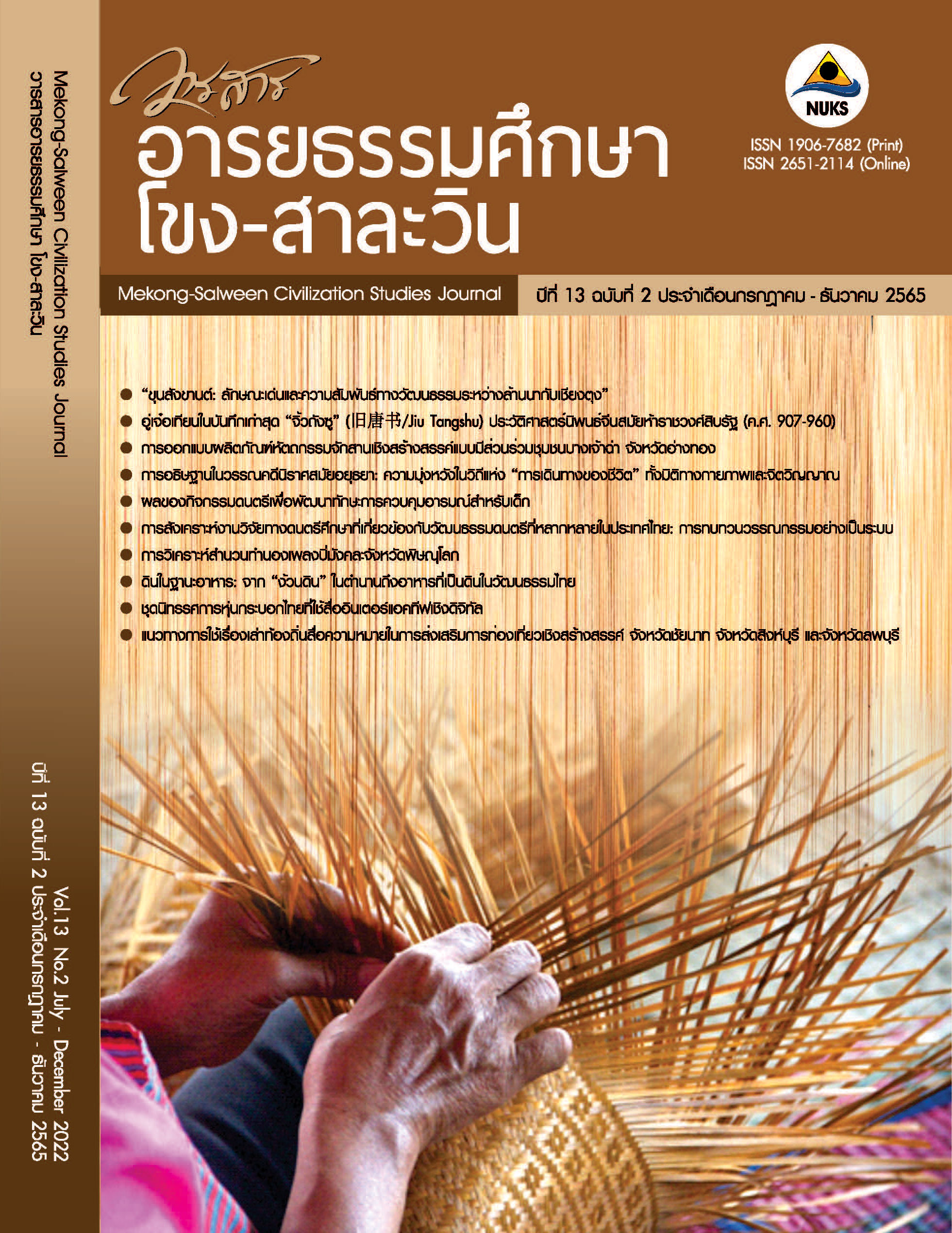Prayer in Nirat Literature of the Ayutthaya Period: Determination in the “Journey of life” Both Physical and Spiritual Dimensions การอธิษฐานในวรรณคดีนิราศสมัยอยุธยา: ความมุ่งหวังในวิถีแห่ง “การเดินทางของชีวิต” ทั้งมิติทางกายภาพและจิตวิญญาณ
Main Article Content
Abstract
This research paper aimed to study and analyze the characteristics of prayer as an important motif that appeared in Nirat Literature of the Ayutthaya Period and to analyze the meaning of “the Journey of life” reflected in prayer motif through those literary works. In this study, content analysis was employed. The scope of study focused on 9 Nirat Literature which were founded in the same period of Ayutthaya. The results revealed that there were 2 types of prayer’s characteristics: 1) prayer for oneself and one’s beloved and 2) prayer for others. Besides, the prayer motif reflected human determination in the “Journey of life” in 2 related dimensions: 1) Physical dimension was the journeys of this life which were mostly related to complete the assigned missions successfully. In this dimension, the prayer held the keys to recover from their emotional pain and give the hope for safe journey and mission accomplishment. This dimension focused on happiness in secular level. 2) Spiritual dimension was the journeys of the learnt and experienced mind from the outside journeys which resulted in raising one’s spirit to higher mental state. This dimension focused on happiness in religious level.
Downloads
Article Details

This work is licensed under a Creative Commons Attribution-NonCommercial-NoDerivatives 4.0 International License.
References
Assavavirulhakarn, P. (2014). Bodhisatva Caryā: The Path for All Living Things. (2nd ed.). Bangkok: Research and Publication Division, Faculty of Arts, Chulalongkorn University.
Boonsong, B. (2009). The life and contributions of Joseph Cambell to the study of mythology. (Doctoral dissertation). Naresuan University, Pitsanulok.
Chanawong, P. (1985). Nirat Literature. Nakornsrithammarat: Academic Textbooks for Teachers’ college program inNakornsrithammarat.
Chittasophon, A. (1978). Nirat Literature. Chiang Mai: Faculty of Humanities, Chiang Mai University.
Ketmankit, K. (Ed.), (1999). Thai literary works of the Ayutthaya period translated version. (2nd ed.). Bangkok: Thailand's National Team on Anthology of ASEAN Literatures.
Khlong Nirat Kawee Boran. (1924). Bangkok: Sophonpipatthanakorn Press.
Literature and History institute of Fine Arts Department. (2013). National Literature Vol.1. Bangkok: Literature and History institute.
Na Nakhon, P. (2003). Nirat Hariphunchai. Bangkok: Pattanasuksa.
Na Thalang, S. (2014). Folklore Theory: Scientific Methods of Analysis of Mythology-Folk Tales. (3rd ed.). Bangkok: Chulalongkorn University Press.
Pengchan, P. (2013). Spiritual pilgrimage in Buddhism. Bangkok: Mental Health Press.
Pongsapich, A. (1976). Popular Buddhism. Journals of Social Sciences, 13(1), 27-44.
Pongsripian, W. (2019). Rudhiraja Ramban (Nirat Hariphunchai): A Poem on the journey to the great reliquary of Hariphunchai & the inscription of Wat Phra Yun. Bangkok: Matichon.
Royal Institute of Thailand. (2013). The Royal Institute Dictionary, BE 2554 (2011) (2nd ed.). Bangkok: Royal Institute of Thailand.
Ruengruglikit, C. (2004). Early Ayutthaya literature: Mutual characteristics and influence. (2nd ed.). Bangkok: Research and Publication Division, Faculty of Arts, Chulalongkorn University.
Ruttanalum, W. (2013). BELIEF IN THE SARABURI BUDDHA'S FOOTPRINT AND THE TRADITION OF "PAI PHRA BAT" IN CREATING THAI LITERARY TEXTS (Master thesis). Bangkok: Chulalongkorn University.
Siricharoen, L. (1974). Guidebook for Kumsuan Sriprach. Bangkok: Bannakij Trading.
Srimahosot. (2018). Khlong Chaleomprakiet King Narai the Great, Khlong Nirat Nakornsawan, Kap Ho Khlong, Khlong Aksorn Sam. Bangkok: Literature and History, Fine Arts Department.
Sriworapoj, B. (Ed.), (2001). Rachapilarbkumchan. Bangkok: Fine Arts Department.
Sujjapun. R. (1973). Klong Niras: An analytical and comparative study with other types of niras (Master thesis). Bangkok: Chulalongkorn University.
Supanvanit, I. (2004). Ideal of happiness in Sukhothai period: Reflection from the inscription. Thai Language and Literature Journal, 21, 66-85.
Thammathibet, Prince. (2011). Biography and Works of Prince Thammathibet. Bangkok: Petchkarat.
Theekaprasertkul, P. (2017). Blessing in Thai Panegyric Literature. Journal of Thai Studies, 13(1), 73-100.
Thompson, S. (1977). Motif-index of folk-literature. (Rev. ed.,Vol 6). Bloomington: Indiana University Press.


